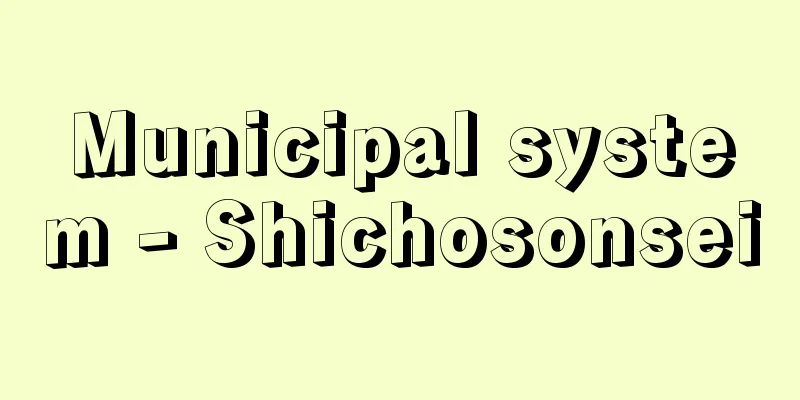Municipal system - Shichosonsei

|
A system that stipulates the organization, authority, and operation of cities, towns, and villages as local public entities. In Japan, the large district and small district system was enacted in 1872 (Meiji 5), followed by the County, District, Town, and Village Organization Act of 1878, and then the City, Town, and Village System (Law No. 1 of Meiji 21) in 1888. Before the system came into effect, large-scale mergers of towns and villages were forced through, and the system was implemented in April of the following year for the cities, towns, and villages that were created by the mergers (excluding Hokkaido and Okinawa), and the system of cities, towns, and villages as local governments was established. However, many of the affairs of cities, towns, and villages were delegated by the national and prefectural governments, and the system was operated under the supervision of the government, so they had more of a character as subordinate organizations of the national government than as local governments. After that, revisions were made to the system, such as expanding the voting rights that were only granted to the wealthy and relaxing supervision, but the basic system remained unchanged until just after World War II. After the war, the Local Autonomy Law (Law No. 67 of 1947) enacted gave cities, towns, and villages the autonomy to be called ordinary local public entities, and prefectures were also made into local governments. In addition, their relationship with the national government was made equal, and general national supervision was abolished. The public election of city, town, and village mayors, the right of direct claims by residents, and other features were institutionalized, and they were able to enact ordinances with authoritarian restrictions, giving them the characteristics of a regional governing body. However, due to insufficient financial resources and the fact that many tasks were delegated to them by the national government, they were actually subject to various forms of control from the central government ministries. As a result, there was a strong demand for the transfer of authority and financial resources to establish autonomy for cities, towns, and villages, and in July 1999, a major legal reform was enacted toward decentralization (the Local Decentralization Omnibus Law). As of March 2010, there were 786 cities, 757 towns, 184 villages, and 23 special wards in Tokyo. [Takagi Shosaku and Tsujiyama Yukinori] "The History of the Local Government System, by Nakagawa Tsuyoshi (1990, Gakuyo Shobo)" ▽ "Decentralization and Big Cities, by Takayori Shozo (1995, Keiso Shobo)" ▽ "The Collected Works of Fukushima Masao, Volume 9: Local Government System, by Fukushima Masao (1996, Keiso Shobo)" ▽ " The Establishment of the Town and Village System, edited by the Archives of the National Institute of Japanese Literature (1999, Meishu Publishing)" ▽ "The Prototype of Modern Local Government: A Study of the Meiji Local Government System, by Tomaru Taisuke (2000, Otsuki Shoten)" ▽ "The Origin of the Meiji Local Government System, by Matsuzawa Yusaku (2009, University of Tokyo Press)" [Reference items] | | | Local | | |Source: Shogakukan Encyclopedia Nipponica About Encyclopedia Nipponica Information | Legend |
|
地方公共団体としての市・町・村の組織、権限、運営を定めた制度。日本では、1872年(明治5)からの大区小区制、1878年の郡区町村編制法を経て、1888年に市制町村制(明治21年法律第1号)が制定された。その施行前に町村の大合併が強行され、翌年4月、合併で誕生した市町村にその制度が施行され(北海道、沖縄を除く)、自治体としての市町村の制度が確立した。しかし、市町村の事務の多くは国・府県の委任事務で、官の監督を受けて運営する制度であったから、自治体というよりは国の下部団体的性格の強いものであった。その後、有産者だけに認めていた選挙権の拡張や監督の緩和などの改正は行われたが、制度の基本は第二次世界大戦直後まで変わらなかった。 戦後、1947年制定の地方自治法(昭和22年法律第67号)で、市町村は普通地方公共団体とよぶにふさわしい自治権が与えられ、都道府県もまた自治体とされた。また、国との関係も対等となり、国の一般的監督は廃止された。市・町・村長の公選制、住民の直接請求権なども制度化され、権力的な規制を伴う条例を制定できるなど、地域の統治団体としての性格を有している。しかし、財源が不十分なうえ、国の機関委任事務が多いため、実際には中央各省から種々の統制を受けてきた。そこで、市町村の自治を確立するために、権限や財源の移譲が強く要請され、1999年(平成11)7月に地方分権に向けての大幅な法改正(地方分権一括法)が行われた。2010年3月時点で、市786、町757、村184、ほかに東京特別区23。 [高木鉦作・辻山幸宣] 『中川剛著『地方自治制度史』(1990・学陽書房)』▽『高寄昇三著『地方分権と大都市』(1995・勁草書房)』▽『福島正夫著『福島正夫著作集 第9巻 地方制度』(1996・勁草書房)』▽『国文学研究資料館史料館編『町村制の発足』(1999・名著出版)』▽『都丸泰助著『現代地方自治の原型――明治地方自治制度の研究』(2000・大月書店)』▽『松沢裕作著『明治地方自治体制の起源』(2009・東京大学出版会)』 [参照項目] | | | | | |出典 小学館 日本大百科全書(ニッポニカ)日本大百科全書(ニッポニカ)について 情報 | 凡例 |
>>: Municipal merger - Shichoson Gappei
Recommend
Fire duration - Fire extinguisher time
The standard heating temperature curve (Figure 2)...
Predatory dumping
…There is also exchange dumping, in which the exc...
King Daiitoku
One of the Five Great Wisdom Kings. Placed in the...
Atkinson, L.
…The name “Bauticism” was coined by the poet E. P...
Yugantar (English spelling)
…After returning to India, he was devoted to Rama...
Imperial House Law
A law that stipulates important matters related t...
Emperor Keikō
The 12th Emperor according to the Imperial geneal...
Quadrivium - Quadrivium
... In terms of content, natural science is often...
International Christian University
…A private Christian university with its headquar...
Teikenshuu
Peking opera actor. Female actor. Born in Beijing...
Godmother - Kyobo
...Children live in a cottage system, where they ...
Aster sublatus (English spelling) Astersublatus
...There are many ray-shaped florets, but the ray...
Argand Light - Argand Light
...This type of lamp had the oil pan placed highe...
Liver function test
A liver function test is a test in which a blood s...
Swordsman - Kaishu
…Therefore, various instruments were used dependi...
![Isobe [town] - Isobe](/upload/images/67caeb55e008b.webp)








